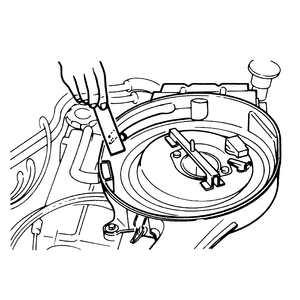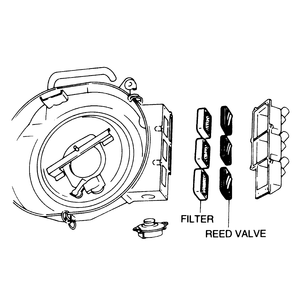This system is usually trouble-free. One symptom of improper operation would
be a high hydrocarbon emissions reading, assuming the basic engine functions,
including idle mixture adjustment, are okay. To check the reed valves for proper
function, proceed as follows:
- Run the engine until it is fully warmed up. Shut off the engine and remove
the air cleaner cover and element. Get a small piece of ordinary paper.
- Place the paper against the inlet port for the air injection system. Have
someone start the engine and let it idle. Air flowing into the system should
draw the paper against the air inlet.
| Fig. 1: Checking pulse air injection system — 1983–84
626

|
| Fig. 2: Exploded view of common pulse air injection
system reed valves

|
- Accelerate the engine until it reaches 1,500 rpm, and check that the exhaust
pressure does not force the paper away from the air inlet.
- If either test is failed, replace the reed valves.
- The air control valve (ACV) must be checked before the reed valves. It is
located on the side of the air cleaner. Disconnect the vacuum hose, remove
the screws and the mounting bracket, then remove the air control valve. Connect
a vacuum source to the valve, and tee in a vacuum gauge. (You can use engine
vacuum to do this, if you pinch off the vacuum line before having someone
start the engine. Be careful to gradually unpinch the line when releasing
vacuum to the gauge and valve.)
- Apply vacuum gradually while watching the stem of the air control valve
and the vacuum gauge. The valve stem must start to move at 7.1–11.0
in. Hg (180–279mm Hg). If the valve does not pass this test, replace
it. If it does pass, install the ACV back onto the air cleaner, leaving the
gauge and vacuum source connected to it.
- Apply a source of vacuum to the air control valve. Vacuum must be 20 in.
Hg. (508mm Hg). If necessary, start the engine. Now, lift off the top of the
air cleaner. Check to make sure there is air flow into the ACV intake, accessible
from the inside of the air cleaner. Have someone accelerate the engine to
2,550 rpm, then check the ACV intake again to make sure exhaust gas is not
being expelled. If either test is failed, replace the reed valve.



